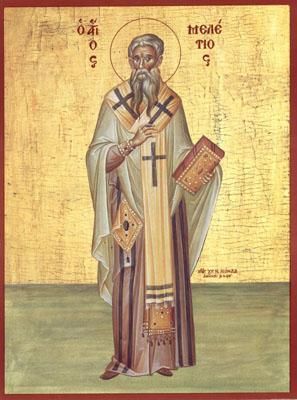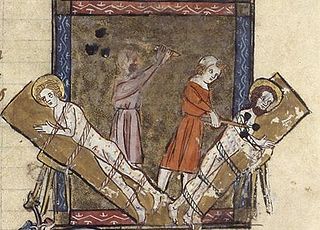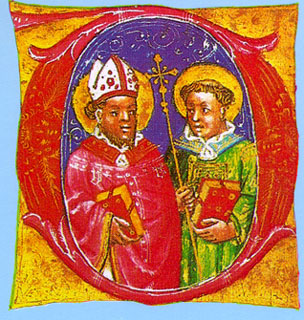The 340s decade ran from January 1, 340, to December 31, 349.

Saint Meletius was a Christian bishop of Antioch from 360 until his death in 381. He was opposed by a rival bishop named Paulinus and his episcopate was dominated by the schism, usually called the Meletian schism. As a result, he was exiled from Antioch in 361–362, 365–366 and 371–378. One of his last acts was to preside over the First Council of Constantinople in 381.
In the history of Christianity and later of the Roman Catholic Church, there have been several Councils of Aquileia. The Roman city of Aquileia at the head of the Adriatic is the seat of an ancient episcopal see, seat of the Patriarch of Aquileia.

Eusebius of Vercelli was a bishop from Sardinia and is counted a saint. Along with Athanasius, he affirmed the divinity of Jesus against Arianism.

July 2 - Eastern Orthodox Church calendar - July 4

Altinum was an ancient town of the Veneti 15 km SE of modern Treviso, close to the mainland shore of the Lagoon of Venice. It was also close to the mouths of the rivers Dese, Zero and Sile. A flourishing port and trading centre during the Roman period, it was destroyed by Attila the Hun in 452. The town recovered, but was later abandoned when sea-borne sand began to cover it over. Its inhabitants moved to Torcello and other islands of the northern part of the lagoon.

Saints Gervasius and Protasius are venerated as Christian martyrs, probably of the 2nd century. They are the patron saints of Milan and of haymakers and are invoked for the discovery of thieves. Their feast day in the Latin Rite of the Catholic Church is 19 June, the day marking the translation of their relics. In the Eastern Orthodox Church and in the Eastern Rites of the Catholic Church, their feast takes place on 14 October (O.S.)/24 October (N.S.), the traditional day of their death. In Christian iconography their emblems are the scourge, the club and the sword.
Alban of Mainz was a Catholic priest, missionary, and martyr in the Late Roman Empire. He is venerated as Saint Alban of Mainz in the Catholic Church, not to be confused with Saint Alban of Verulamium.

The Patriarchate of Aquileia was an episcopal see in northeastern Italy, centred on the ancient city of Aquileia situated at the head of the Adriatic, on what is now the Italian seacoast. For many centuries it played an important part in history, particularly in that of the Holy See and northern Italy, and a number of church councils were held there.

Saint Liberalis of Treviso is a saint of the 4th century. Tradition states that he was a priest who opposed Arianism and that he was persecuted at Ancona.

The Basilica of Sant'Ambrogio is an ancient Romanesque-style, Roman Catholic church in the center of Milan, region of Lombardy, Italy.

Saint Chromatius was a bishop of Aquileia.

Saint Hermagoras of Aquileia is considered the first bishop of Aquileia, northern Italy. Christian tradition states that he was chosen by Saint Mark to serve as the leader of the nascent Christian community in Aquileia, and that he was consecrated bishop by Saint Peter. Hermagoras and his deacon Fortunatus evangelized the area but were eventually arrested by Sebastius, a representative of Nero. They were tortured and beheaded.
Saint Theonistus is a saint venerated by the Catholic Church. Theonistus is venerated with two companions, Tabra and Tabratha. Medieval documents give accounts of his life, which are contradictory and confused.

Eleutherius (or Eleut erus or Eleftherios; sometimes called Liberalis or Liberator, the former transliterations and the latter translations of his and his mother Antia are venerated as Christian saints and martyrs in Greece and Albania.

Saint Vigilius of Trent is venerated as the patron saint and bishop of Trent. He should not be confused with the pope of the same name.
The Council of Aquileia in 381 AD was a church synod which was part of the struggle between Arian and orthodox ideas in Christianity. It was one of five councils of Aquileia.
Secundianus of Singidunum was bishop of Singidunum. Little is known of his life; except that he was condemned for heresy at the Council of Aquileia in 381.
Palladius of Ratiaria was a late 4th century Arian Christian theologian, based in the Roman province of Dacia in modern Bulgaria.

Justus of Lyon was the 13th Bishop of Lyon. He succeeded Verissimus in the mid-4th century. He is venerated as a saint by both the Catholic and the Orthodox Church, with a feast day on 2 September. Around 350, Justus was made Bishop of Lyon. As bishop of the capital of Gaul, he was among the participants of the Council of Valencia of 374 regarding religious discipline of the clergy and the faithful. He later became a hermit.













